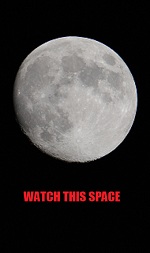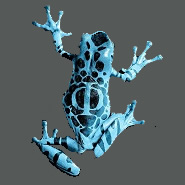Strange. I keep subscribing to LunaCognita’s YouTube channel, but it just doesn’t stick for some reason.
In any event, the nearly year-old second video in this thread caught my eye in a thread about it at my hangout, ATS, started by Arken. Being, as many of you know, a fan of LC’s work, I needed to share it with you and wound up including the first video shown here, which is a very recent one.
On this first one, Luna uses the frame stacking technique to bring out the details. For the doubters let me just say that this method is 100% legitimate, is used daily by photographers the world over and works really well. It is very handy and I have used it myself with great results. It is not destructive in the slightest, quite the opposite, actually, it does not add anything that is not already there. Luna adds a touch of contrast is added later here to bring the thingies out just a bit more and that is quite alright considering the condition of the initial frames.
One wonders if the objects are what was intended to be filmed.
I would imagine so, as film stock was a finite commodity.
There are some who might say that these are detritus within the camera or the command module. I’ll just say they certainly don’t seem that way to me.
Uploaded by LunaCognita on Jan 18, 2012
Hi again everyone. This presentation focuses on taking a closer look at a 23.5-second segment of 16mm DAC motion picture footage from the NASA archives that was originally exposed over 40 years ago during the Apollo 12 mission (November 1969). This footage was shot with the DAC camera mounted near a window in the Command/Service Module while the spacecraft was in lunar orbit above the Moon.
Unfortunately, this raw footage, as it is officially archived by NASA, appears to have been over-exposed and accidentally ruined when the lens on the 16mm DAC camera aboard the spacecraft somehow became unintentionally fogged over shortly before filming began. Because of this, this film sequence only affords us a blurry, obfuscated view out the spacecraft window, showing an oblique look at the sunlit (and overexposed) lunar surface with a portion of the lunar limb also visible.
While the raw footage is of poor quality, it does however still contain some viable image data that can be recovered and revealed thru enhancement. The application of various frame-stacking and averaging enhancement techniques can allow us to extract significantly more detail from the scene than the raw archive frames of footage alone appear to surrender. These stack enhancements will allow you to see what appears to be at least three unidentified objects transiting in front of the lunar disc that were actually caught on film here.
Unfortunately, the lack of viable image data and over-exposed nature of the raw footage provides does not allow for a high-detail look at these three distinct contrast targets, so that raises the possibility that one of these moving contrast targets is actually a shadow from one of the unidentified objects above being dropped onto the lurain. The high sun angle that we know was illuminating this scene at the time could certainly allow for that possibility, but would require us to make the unsupported assumption that these unidentified objects are very close to the Moon and are scooting just above the lunar surface.
The reality is that there is simply no way to accurately determine or even estimate any range or size data for these unidentified objects shown. What we can say is that multiple objects can be seen transiting the lunar disc here and can be determined to at the time have been located somewhere in 3-D object space between the camera aboard the CSM spacecraft and the surface of the Moon.
Cheers everyone, and thanks for watching!
LunaCognita
Pretty neat, eh?
I think so.
On to the next one.
The description below pretty much says it all as usual. And as usual the production values are to a very high standard which I appreciate being trained as a filmmaker and all. Wish I could find my old After Effects CD in the rubble of my local environs. Had to put in a new C drive array, needs to go back in. Luna’s films always stoke that urge in me and I do actually have a very interesting sequence of still images that are just itching to be a joined together as a movie. The depression always gets in the way, though. Always. Oh, man, I hope they’re not on the dead Glyph, as I can’t afford to send it out for repair and naturally it’s a stripe so the data on it is in cosmic hands. Sigh.
Good gracious, how did that off topic rant get in here? Didn’t derail things too badly, methinks.
Respected realist Phage, who I like a lot, was saying, among others, that some of the irregularly shaped objects you will see are the aforementioned detritus and anomalies with the film or processing or scanning. Maybe some are. Maybe not. I have seen such flaws on many images. Many are quite obvious and some scanner dust artifacts can look pretty strange. Some of them here at the least I would say are surely not flaws.
Man, I haven‘t pored over “originals” in so long and now don’t have much time to do it anyway, but, I finally got a nice big tiff of the image with the notorious Shard on it yesterday. As is so typical, however, I’ve not even opened it yet. But at least I have it. Always wanted it. Go me.
Anyway, I could go on and on like that for ages, so to spare you from further horror I will say here you go…
Uploaded by LunaCognita on Mar 11, 2011
This presentation is a simple compilation of some more anomalous photographs and 16mm DAC film footage that I have archived during my years of research and investigation looking into the activities of the National Aeronautics and Space Administration.
The images and footage shown here were taken during the Apollo program, filmed by the astronaut flight crews during their journeys to and from the Moon.
Most of what I show here involves “lunar transients” – unidentified objects in space that were captured on film as they transited in front of (or passed near) a celestial body such as the Moon or Earth. I believe many of these objects are not on the lunar surface, but rather were above the lunar surface when captured on film.
I also include several examples of NASA image obfuscation as well, just to help highlight the fact that the space agency also removes anomalous objects from frame in order to “sanitize” scenes prior to official archive release so as to ensure they do not reveal too much of the truth about what is really up there.
Hope you enjoy!
Cheers,
LCHere are a few links to the last set of images I show, dealing with the detection of cropping obfuscation being employed to sanitize the scenes.
NASA “Gateway” archive link to frame#AS11-36-5319 – shows object off the Earth’s limb.
http://eol.jsc.nasa.gov/scripts/sseop/photo.pl?mission=AS11&roll=36&f…NASA “LPI” archive version of #AS11-36-5319 that does not show the object (residue of the cropping is detectable under enhancement)
http://www.lpi.usra.edu/resources/apollo/images/print/AS11/36/5319.jpgCropping proof – second last image shown (AS16-118-18873).
ftp://nssdcftp.gsfc.nasa.gov/miscellaneous/planetary/apollo/a16_h_118_18873.tiffCropping proof – Last image shown (AS13-60-8588).
ftp://nssdcftp.gsfc.nasa.gov/miscellaneous/planetary/apollo/a13_h_60_8588.tiff
Thanks, Cary, well done, man, well done.
Peace.






































 What’s All This, Then? is copyright © 2009 to the present by Ignatius F Makarevich - All rights reserved worldwide.
What’s All This, Then? is copyright © 2009 to the present by Ignatius F Makarevich - All rights reserved worldwide.


